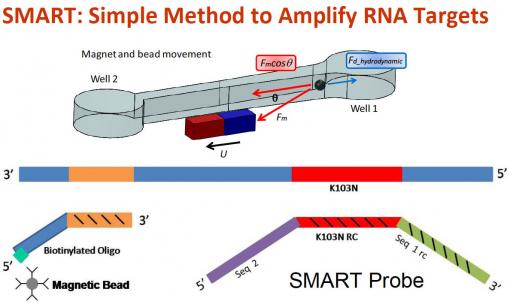By Kalwinder KaurJun 11 2012
A fast and reliable flu-detection test has been developed by researchers at Brown University.
 SMART Probe
SMART Probe
This kit can be easily accommodated in a first-aid kit. The prototype device uses both microfluidics and magnetics techniques to separate the influenza RNA. It then amplifies and identifies probes that are attached to the RNA. The innovative technology may promote tracking of influenza in real-time. Study results have appeared in the Journal of Molecular Diagnostics.
Back in April 2009, the H1N1 or swine flu virus mutated from pigs and was being transmitted from human to human. According to the World Health Organization, this virus killed over 18,000 people across the globe and was termed as the first global pandemic in over 40 years. Devices to combat such outbreaks are expensive and not reliable.
To overcome these issues, biomedical engineers at Memorial Hospital in Rhode Island and Brown University have designed a biochip that is capable of detecting the presence of pathogen. The device pinpoints particular RNA sequences and then uses small magnets to isolate the sequence that contains the flu from the remaining RNA strand. The end result is a rapid and reliable flu-detection test that could be used just like an iPhone.
Anubhav Tripathi, associate professor at Brown University, informed that the new device is affordable and can be used for on-site detection of various diseases like TB, HIV, or influenza.
The assay labeled as SMART stands for “A Simple Method for Amplifying RNA Targets.” It features a series of tubes that have bulbs on each end. In the SMART detector, a DNA probe with base letters is used, wherein the letters correspond with the code in the targeted sequence. The probe fastens to a particular RNA strand that is being assayed. The sample is then submerged with probes in order to make sure that all RNA molecules are attached to the probes. The team then fixed the probes to magnetic beads, which transport the genetic sequence for the flu RNA sequence. A magnet is then used to pull the RNA-probe pairs that are accumulated in the bulb via a tube and then the probes are deposited at a bulb at the other end. This junction of magnetism and microfluidics isolates the RNA-probe pairs from the adjacent biological debris, enabling clinicians to separate the flu strains easily and quickly for analysis. After isolating the RNA, it can be studied by nucleic acid sequence-based amplification (NASBA) method.
For biohazard detection, the research team is exploring separate technologies.
The study was funded by the National Science Foundation and the U.S. National Institute of Health.
Disclaimer: The views expressed here are those of the author expressed in their private capacity and do not necessarily represent the views of AZoM.com Limited T/A AZoNetwork the owner and operator of this website. This disclaimer forms part of the Terms and conditions of use of this website.